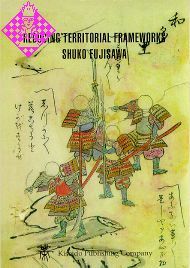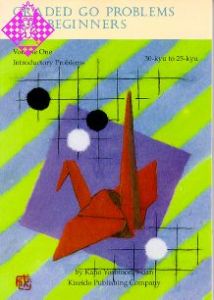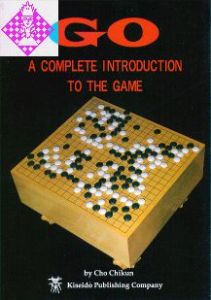Article Number
LGSHURTF
Author
Reducing Territorial Frameworks
200 pages, paperback/pocketbook, Kiseido, 2. edition 1997
Discontinued
The aim of a reducing move is similar to that of an invasion, in that it tries to prevent the opponent from enlarging his area. Limiting the expansion of his territorial framework (moyo) or reducing its size may not bring you actual profit locally, but in the overall context it maintains territorial balance, so it is a large-scale strategy. That means that you have to make a cool assessment of the overall position and that you have to articulate a strategy of defence and offence that applies to the whole board.
The reducing move is not directly a fighting technique. However, it often serves as preparation for fighting elsewhere or provokes a counterattack that makes fighting unavoidable. In contrast to the concreteness of an invasion, both the aim and the execution of a reducing move are abstract. Rather than local tactical skills, an overall strategic vision is called for, but for this very reason it is necessary to master its basic concepts and techniques. It may not be a fighting technique, but you must always be ready to fight.
The first chapter of this book discusses the basic concepts of the reducing move. The next three chapters give a systematic presentation of the important patterns or josekis. The fourth chapter attempts to give the reader a feeling for how reducing manoeuvres function in the context of whole-board planning by examining the strategic choices involved in deciding between reducing and invading, between surrounding and expanding territory. The final chapter looks at examples, presented as pick-the-next-move problems, taken from my games. The most difficult stage in a game of go is the transition from the opening to the middle game. To steer your course safely through this stage, a sound grasp of the theory and practice of reducing and invading is essential, and acquiring such a grasp is the first step towards giving your game greater profundity.
I would like to acknowledge the invaluable assistance of the go writer Aiba Kazuhiro in putting together this book. I would also like to express my gratitude to the Ishi Press for making an Englishlanguage version available to go fans around the world. I hope that it can make a contribution to your understanding and appreciation of the game.
Fujisawa Shuko, preface
The reducing move is not directly a fighting technique. However, it often serves as preparation for fighting elsewhere or provokes a counterattack that makes fighting unavoidable. In contrast to the concreteness of an invasion, both the aim and the execution of a reducing move are abstract. Rather than local tactical skills, an overall strategic vision is called for, but for this very reason it is necessary to master its basic concepts and techniques. It may not be a fighting technique, but you must always be ready to fight.
The first chapter of this book discusses the basic concepts of the reducing move. The next three chapters give a systematic presentation of the important patterns or josekis. The fourth chapter attempts to give the reader a feeling for how reducing manoeuvres function in the context of whole-board planning by examining the strategic choices involved in deciding between reducing and invading, between surrounding and expanding territory. The final chapter looks at examples, presented as pick-the-next-move problems, taken from my games. The most difficult stage in a game of go is the transition from the opening to the middle game. To steer your course safely through this stage, a sound grasp of the theory and practice of reducing and invading is essential, and acquiring such a grasp is the first step towards giving your game greater profundity.
I would like to acknowledge the invaluable assistance of the go writer Aiba Kazuhiro in putting together this book. I would also like to express my gratitude to the Ishi Press for making an Englishlanguage version available to go fans around the world. I hope that it can make a contribution to your understanding and appreciation of the game.
Fujisawa Shuko, preface
| Weight | 180 g |
|---|---|
| Manufacturer | Kiseido |
| Medium | Book |
| Year of Publication | 1997 |
| Author | Fujisawa Shuko |
| Language | English |
| Edition | 2 |
| Pages | 200 |
| Binding | paperback/pocketbook |
| Name | Kiseido Publishing Company |
|---|
v Preface
vi Translator's Preface
viii Glossary of Japanese Terms
001 Chapter One: The Basics of Reducing
001 Reduce or invade?
002 The objectives of reducing moves
016 Where to reduce
021 Priority in reducing
023 Making preparations for reducing
025 Conclusion
Chapters Two to Four: Reducing Move Josekis
027 Chapter Two: Reducing the Side
028 1. The Simple Shoulder Hit
035 2. Shoulder Hit Against the Two-Space Extension
042 3. The Capping Move
065 4. The Knight's Move
072 5. The Large Knight's Move
075 6. The Ear
078 7. The Side Contact Play
088 8. Attaching on Top
093 9. One's Best Guess
102 Chapter Three: Reducing Corner Enclosures
102 1. The Small Knight Enclosure
114 2. The One-Space Enclosure
120 3. The Large Knight Enclosure
124 4. The Star-Point Enclosure
129 Chapter Four: Reducing the Chinese-Style Fuseki
129 1. Reducing the Low Chinese-Style Fuseki
137 2. The High Chinese-Style Fuseki
144 Chapter Five: Attack and Defence
170 Chapter Six: Problems
vi Translator's Preface
viii Glossary of Japanese Terms
001 Chapter One: The Basics of Reducing
001 Reduce or invade?
002 The objectives of reducing moves
016 Where to reduce
021 Priority in reducing
023 Making preparations for reducing
025 Conclusion
Chapters Two to Four: Reducing Move Josekis
027 Chapter Two: Reducing the Side
028 1. The Simple Shoulder Hit
035 2. Shoulder Hit Against the Two-Space Extension
042 3. The Capping Move
065 4. The Knight's Move
072 5. The Large Knight's Move
075 6. The Ear
078 7. The Side Contact Play
088 8. Attaching on Top
093 9. One's Best Guess
102 Chapter Three: Reducing Corner Enclosures
102 1. The Small Knight Enclosure
114 2. The One-Space Enclosure
120 3. The Large Knight Enclosure
124 4. The Star-Point Enclosure
129 Chapter Four: Reducing the Chinese-Style Fuseki
129 1. Reducing the Low Chinese-Style Fuseki
137 2. The High Chinese-Style Fuseki
144 Chapter Five: Attack and Defence
170 Chapter Six: Problems
More from Kiseido
-
 Get Strong at the Opening€19.50
Get Strong at the Opening€19.50 -
 Get Strong at the Endgame€19.50
Get Strong at the Endgame€19.50 -
 Go World Archive€120.00
Go World Archive€120.00 -
 Get Strong at Tesuji€19.50
Get Strong at Tesuji€19.50 -
 Go World No. 129€4.95
Go World No. 129€4.95 - More from Kiseido



